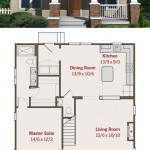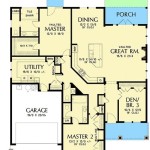How To Use Graph Paper For Floor Plan Design
Creating a floor plan is a vital step in any architectural, interior design, or remodeling project. It provides a scaled representation of a space, allowing for visualization, planning, and accurate execution. While sophisticated software is available for creating floor plans, graph paper remains a useful and accessible tool, particularly for initial concept development, quick sketches, and smaller projects. Understanding how to use graph paper effectively for floor plans empowers individuals to translate ideas into tangible designs, fostering creativity and precision in the planning process.
This article details the systematic approach to using graph paper for floor plan design. It encompasses selecting appropriate materials, accurately measuring the space, transferring those measurements onto the graph paper, and incorporating common architectural symbols. Adhering to these steps will result in a clear and usable floor plan.
1. Gathering Necessary Materials and Understanding Scale
The first step in creating a floor plan on graph paper involves gathering the necessary materials. These include:
*Graph paper:
Choose graph paper with a small grid size. Common sizes are 1/4-inch or 1/8-inch grids, representing smaller increments of measurement. The smaller the grid, the more detailed the floor plan can be. Larger projects may necessitate larger sheets of graph paper. *Pencils:
Use a variety of pencils with different lead hardness. A harder lead (e.g., 2H or 4H) is suitable for light construction lines and initial sketches. A softer lead (e.g., HB or 2B) is better for darker, more defined lines and labeling. *Eraser:
A good quality eraser is essential for correcting mistakes and refining the drawing. Kneaded erasers are particularly useful for lifting graphite without damaging the paper. *Ruler or Scale Ruler:
A ruler is fundamental for drawing straight lines and ensuring accurate measurements. A scale ruler, specifically designed for architectural drawings, simplifies the process of converting real-world measurements to scaled representations on the graph paper. *Measuring Tape:
A reliable measuring tape is crucial for obtaining accurate measurements of the space being documented. Consider using a laser measuring tool for larger spaces to improve efficiency and precision. *Notebook:
A notebook for recording measurements and preliminary sketches is important for keeping track of the design process. *Architectural Templates (Optional):
Architectural templates can aid in drawing standard symbols for doors, windows, and fixtures, ensuring consistency and accuracy.Understanding scale is critical when using graph paper for floor plans. Scale represents the proportional relationship between the drawing and the actual space. A common architectural scale is 1/4 inch = 1 foot, meaning that every 1/4 inch on the graph paper represents 1 foot in the actual room. Other scales, such as 1/8 inch = 1 foot or 1/2 inch = 1 foot, can be used depending on the size of the space and the desired level of detail. Once a scale is selected, it is important to maintain consistency throughout the entire drawing.
To effectively utilize the selected scale, it is imperative to calculate the number of grid squares that correspond to real-world measurements. For example, if using a 1/4 inch = 1 foot scale and the graph paper has 4 squares per inch, then each square represents 3 inches (1 foot / 4 squares = 3 inches/square). Understanding this relationship allows for accurate transfer of measurements from the physical space to the graph paper.
2. Accurately Measuring and Recording the Space
Accurate measurement is the foundation of a reliable floor plan. This step requires meticulous attention to detail and a systematic approach.
*Measure all walls:
Start by measuring the length of each wall in the room or space. Measure along the baseboard, as this tends to be the most accurate and consistent line. Record these measurements in the notebook, clearly labeling each wall. *Measure door and window openings:
Precisely measure the width of each door and window opening, as well as the distance from the adjacent walls to the edge of the opening. Also note the height of windows and doors from the floor. These measurements are critical for accurate placement on the floor plan. *Measure fixed elements:
Measure and record the location and dimensions of any fixed elements within the space, such as fireplaces, built-in shelves, radiators, and plumbing fixtures. Include the distance from these elements to the surrounding walls. *Measure ceiling height:
Note the ceiling height, as this information is essential for interior design and construction purposes. *Account for irregularities:
Pay close attention to any irregularities in the walls, such as alcoves, niches, or angled walls. Measure these features carefully and record their dimensions and angles in the notebook. Consider using a protractor or angle finder to accurately determine angles. *Double-check all measurements:
After completing the initial measurements, double-check each measurement to ensure accuracy. Small errors can accumulate and lead to significant discrepancies in the final floor plan. Ideally, a second person should independently verify the measurements.A best practice is to create a rough sketch of the space in the notebook while taking measurements. This sketch provides a visual reference and helps organize the measurements. As measurements are taken, add them to the corresponding locations on the sketch. This also helps identify any missing or inconsistent measurements that need to be re-checked.
Specifically, when dealing with complex shapes or angles, triangulation can be used. Triangulation involves measuring the distances between three points to define a shape. This technique is particularly useful for accurately representing irregular walls or curved spaces.
3. Transferring Measurements and Adding Architectural Details
Once the measurements are accurately recorded, the next step is to transfer them onto the graph paper, adhering to the chosen scale.
*Establish the perimeter:
Begin by drawing the exterior walls of the space on the graph paper, using the recorded measurements and the selected scale. Use a straight edge or ruler to ensure straight and accurate lines. Lightly sketch the walls first, using a harder lead pencil, then darken the lines once satisfied with their placement. *Add interior walls:
Next, add the interior walls, again using the measurements and scale. Pay attention to the relationship between interior walls and exterior walls, ensuring they are accurately positioned relative to each other. Double-check that the thicknesses of the walls are represented accurately based on typical construction standards. *Draw door and window openings:
Using the measurements recorded earlier, draw the door and window openings on the floor plan. Represent doors with an arc to indicate the direction of swing. Use standard symbols for windows, such as parallel lines or a simplified representation of window panes. *Incorporate fixed elements:
Add the fixed elements, such as fireplaces, built-in shelves, and plumbing fixtures, to the floor plan. Use accurate measurements and scale to ensure their correct placement. Architectural templates can be useful for drawing these elements accurately and consistently. *Add details and annotations:
Add any additional details, such as electrical outlets, light fixtures, or HVAC registers. Annotate the floor plan with dimensions, labels, and notes to provide further clarity and information. For example, label each room with its name (e.g., "Living Room," "Bedroom"). *Review and refine:
After completing the floor plan, carefully review it for accuracy and completeness. Compare the drawing to the original measurements and sketch to ensure that everything is correctly represented. Make any necessary corrections or refinements.Standard architectural symbols are crucial for clear communication on a floor plan. These symbols represent common elements such as doors, windows, stairs, and plumbing fixtures. Familiarizing oneself with these symbols and using them consistently ensures that the floor plan is easily understood by others, including contractors, designers, and homeowners.
When drawing doors, the arc representing the swing should indicate the direction the door opens. For windows, a common symbol is three parallel lines, with the middle line representing the glass pane. Stairs are typically represented with a series of parallel lines indicating the steps, with an arrow indicating the direction of ascent. Plumbing fixtures, such as toilets and sinks, are typically represented with simplified geometric shapes.
Accurate labeling is equally important. Each room should be clearly labeled with its name and dimensions. Walls should be labeled with their thicknesses and materials, if relevant. Important features, such as electrical outlets and light fixtures, should also be labeled. Using consistent and clear labeling ensures that the floor plan is easy to interpret and understand.

How To Draw A Floor Plan Scale Measuring Sketching

A Super Simple Method For How To Draw Floor Plan Hampton Redesign

Create A To Scale Sketch With Graph Paper Make Space Planning Breeze

Create A To Scale Sketch With Graph Paper Make Space Planning Breeze

A Super Simple Method For How To Draw Floor Plan Hampton Redesign

How To Create A Floor Plan And Furniture Layout

Printable Graph Paper For Floor Plans

How To Create A Floor Plan And Furniture Layout

How To Draw A Floor Plan Scale Measuring Sketching

Create A To Scale Sketch With Graph Paper Make Space Planning Breeze
Related Posts








